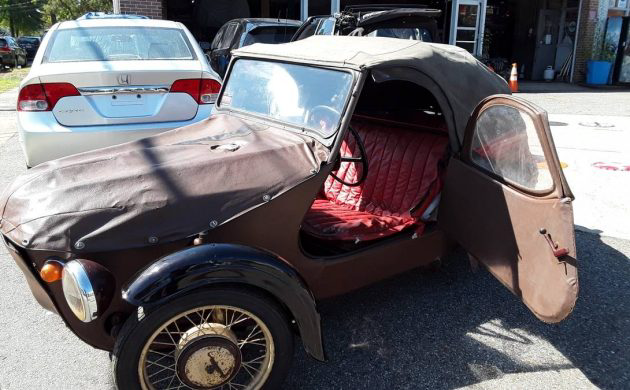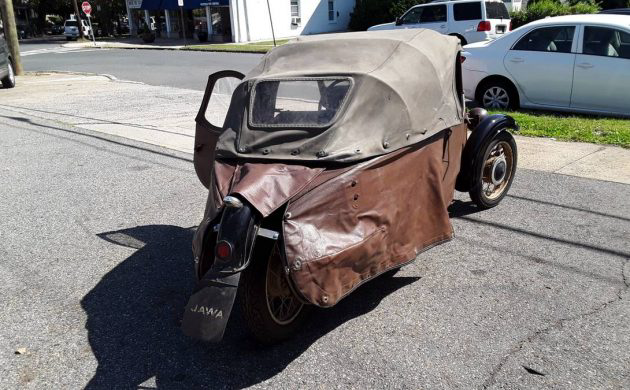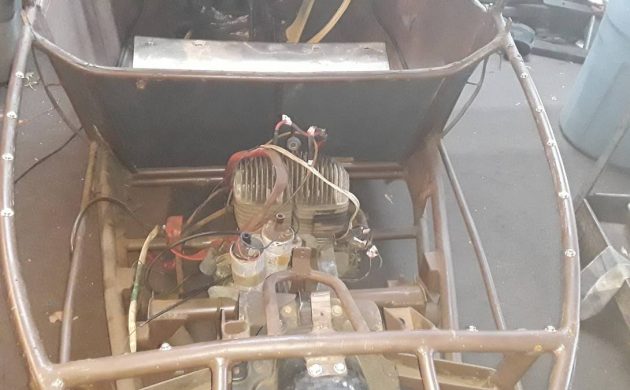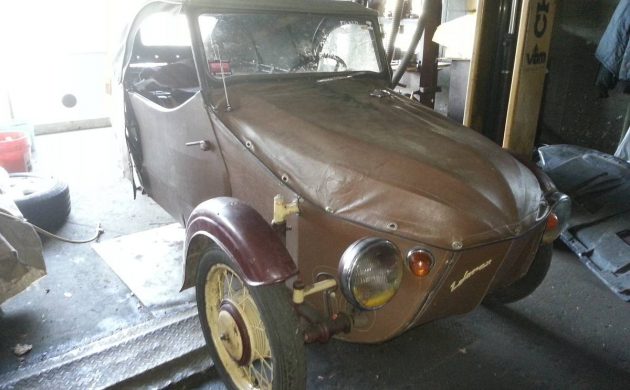Rare Micro-Car: 1969 Velorex 16/350
Finding a classic car with a vinyl top is nothing out of the ordinary. Finding a classic car where all of the body panels are made from vinyl is a whole different kettle of fish. That is precisely what the next owner will be getting if they purchase this 1969 Velorex 16/350, which is located in Westfield, New Jersey. The distinctive piece of motoring history is listed for sale here on Craigslist, with the owner setting a price of $7,500.
Manufacturers have followed different paths throughout the years when it has comes to panel material. We’ve seen steel, aluminum, and now most manufacturers are recognizing the weight benefits of composite materials. And yet none seem to be willing to tackle vinyl. Why? It has its advantages. Rust isn’t an issue, panels are cheap and easy to replace, and a repaint is a piece of cake. In all seriousness, the 16/350 was something of a sales success for Velorex, and a large part of this was due to its simplicity of design and repair. The frame is constructed of steel tubing, which includes the frame for the windshield, and the skeletons of the doors. Over this is stretched a type of vinyl, which is both fairly weather-resistant, but most importantly, it is light. The frame of this Velorex looks like it is solid, with no signs of rust or accident damage. Some of the vinyl panels appear to have stretched over the years, most notably the top, and the sections around the back of the car that shrouds the engine and rear wheel. While some of it might be able to be pulled back into shape, there are some pieces that will require replacement. Still, this is a task that could probably be tackled by most good upholsterers or soft-top manufacturers. The few steel parts on the body such as the fenders look good, as does most of the glass, and the lights.
One of the interesting features of the 16/350 is the height of the seats when compared to the door sills. They are almost identical, which would potentially make accessing the car quite difficult. When you consider that these were primarily designed as transport for people with disabilities, that is a bit strange. Anyway, the interior of the Velorex is quite presentable. As was a characteristic of Eastern Bloc cars of this period, there are few optional or luxury features. The upholstery on the seat looks quite loose, although I think that this is more to do with the foam padding compacting, rather than the vinyl stretching. This is an issue that might be able to be addressed in a home workshop. The floors and dash are timber, but it is hard to ascertain the condition of the floor. There is a hole in the dash that shouldn’t be there, but fabricating a completely new dash should be one of the easiest jobs on the car. It does look like the original Skoda speedometer is still fitted to the dash, while one of the few luxury items is the optional ashtray.
Powering the Velorex is a 343cc Jawa twin-cylinder, air-cooled engine, producing 16hp. This power is sent to the rear wheel via a 4-speed manual transmission and chain drive. With no reverse gear in the transmission, this is one of the areas that create some interest with the Velorex. The engine employs a system called “Dynastarter.” This allows the engine to start and run in its reverse direction, theoretically providing both four reverse gears, and the same potential top speed traveling both forwards and backward. The top speed for the Velorex was around 55mph, but a cruising speed of 35mph was more realistic. One mechanical advantage with this vehicle is that with Jawa motorcycles having been imported into the USA, parts are surprisingly easy to source. The car currently doesn’t run, but hopefully, it shouldn’t take a lot of work to get it mobile once again.
It would be both easy and tempting to fill this article with jokes about the Velorex, but I have avoided most of these for good reason. The company managed to produce around 12,000 of its 16/350 model, with the majority being sold in Eastern Bloc countries such as Hungary, Poland, and East Germany. It is believed that no more than a dozen examples have found their way into the USA, making them a rare sight on our roads. Restoration of these is potentially very easy, and restored examples can sell for some surprising prices. I found one that sold recently that was nice, but not perfect. The owner managed to snare $18,500 for that car. That would tend to indicate that this is a project car that makes good financial sense. It also looks like it would be a hoot to drive once restored. However, if you choose to drive it in reverse at top speed, I will happily watch from a safe distance.
Auctions Ending Soon
 2006 Ford Mustang Saleen S281 SCBid Now5 hours$16,000
2006 Ford Mustang Saleen S281 SCBid Now5 hours$16,000
 2002 Subaru Impreza WRXBid Now3 days$333
2002 Subaru Impreza WRXBid Now3 days$333
 1975 Chevrolet Corvette ConvertibleBid Now3 days$3,000
1975 Chevrolet Corvette ConvertibleBid Now3 days$3,000
 1964 Ford F-100 Camper CustomBid Now3 days$2,000
1964 Ford F-100 Camper CustomBid Now3 days$2,000
 2006 Jeep Wrangler SportBid Now5 days$10,500
2006 Jeep Wrangler SportBid Now5 days$10,500






Comments
In case you couldn’t tell, Velorex’s main product was sidecars, and they were affiliated with Jawa so the engines were easy to source. This engine is probably identical to the one I had in my Jawa Californian; it would just about hit 70 in a 300 pound bike. There are still thousands of Jawas buzzing around Cuba and it probably wouldn’t be hard sneaking the odd piston or Jikov main jet into your luggage. This is a funky car.
SBC. Becuz why not.
Hmm we have a Triumph Daytona 996 triple bike in our tow pound from a light wreck …> Velorex Daytona 3riple ???
There’s a Velorex here in eastern Massachusetts that appears to have the engine, transmission and rear wheel from some variety of Honda motorcycle. I took this photo when the owners were arriving at a car show in Essex, MA.
Looks like a fun ride, though I’d prefer the original powertrain….
You’d lose the reversing ability if you did that; it’ll run backwards because it’s a stroker.
Strangely enough here in Thailand at a local vehicle museum just North of Bangkok, you will find about 6 or 8 of them, along with lots of other small cars.
Fascinating vehicles
Insert vinyl record joke here
And when it gets dirty just take the outer skin off and throw it in the washing machine !!
Too bad ypu can’t get the plans for these
and build an EV version. You wouldn’t
need that big of a battery pack to make
it run great anyway. A 36V system should
do the trick quite nicely. I’ve often wondeted if the top folds down on this one. Anyone know? Basic motoring at
its finest
If your going the EV route you need at least 48 volts. I have a 36 volt bicycle and it will only go about 30 kph. 20 mph. I think a 500cc bike motor would be more than enough. As for reverse you could use an electric motor for that. I have a side car vintage gold wing, like my bike this would push back very easily. Along with the 500cc motor I’d put a machine turned aluminum skin on it, with a bit of copper for contrast. Very cool little cycle car.